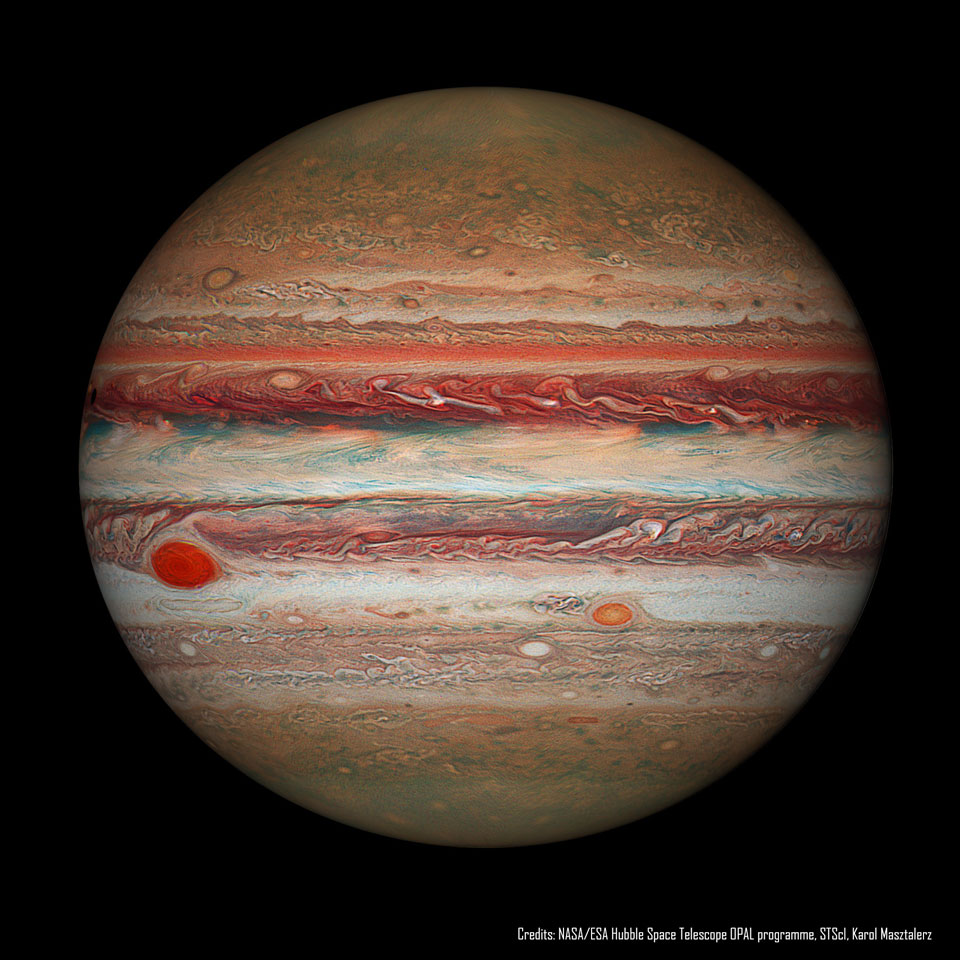2022年1月9日
Hubble’s Jupiter and the Shrinking Great Red Spot
Image Credit: NASA, ESA, Hubble, OPAL Program, STScI; Processing: Karol Masztalerz
Explanation: What will become of Jupiter’s Great Red Spot? Gas giant Jupiter is the solar system’s largest world with about 320 times the mass of planet Earth. Jupiter is home to one of the largest and longest lasting storm systems known, the Great Red Spot (GRS), visible to the left. The GRS is so large it could swallow Earth, although it has been shrinking. Comparison with historical notes indicate that the storm spans only about one third of the exposed surface area it had 150 years ago. NASA’s Outer Planets Atmospheres Legacy (OPAL) program has been monitoring the storm more recently using the Hubble Space Telescope. The featured Hubble OPAL image shows Jupiter as it appeared in 2016, processed in a way that makes red hues appear quite vibrant. Modern GRS data indicate that the storm continues to constrict its surface area, but is also becoming slightly taller, vertically. No one knows the future of the GRS, including the possibility that if the shrinking trend continues, the GRS might one day even do what smaller spots on Jupiter have done — disappear completely.
Tuesday over Zoom: APOD editor to present the Best APOD Space Images of 2021
Tomorrow’s picture: wagging comet tail
哈勃望远镜的木星和缩小的大红斑
影像提供: NASA, ESA, Hubble, OPAL Program, STScI; 影像处理: Karol Masztalerz
说明: 木星大红斑的前程会如何?质量大约是地球320倍的庞然气态木星,是太阳系最大的行星。而在上面影像左侧的大红斑(GRS),更是太阳系现知最大、持续时间最长的风暴系统。大红斑近来逐渐在缩小,和过往的记录比对,显示它目前可见的面积大约只有150年前的3分之1,但仍可轻易吞下地球。哈勃望远镜的外围行星大气传承计画(OPAL),不断在监控这个风暴系统,近来更使用哈勃太空望远镜进行观测。这幅来自OPAL计画的主题影像,经过特别处理让泛红色泽变得极为鲜明,用以突显木星在2016年的样貌。近来的大红斑观测数据指出, 这个风暴系统的表面积持续在缩减,不过垂直的高度却稍有增加。大红斑的前途难卜,很难断言它的面积会不会持续缩减,未来是否会如木星的其他小斑一样消失匿踪。
周二聚焦: APOD编辑将呈现2021年APOD最佳太空图片
明日的图片: wagging comet tail



